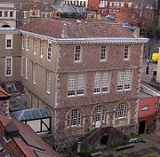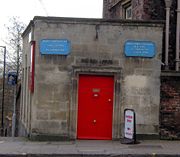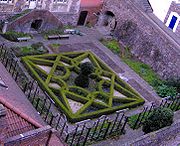
Red Lodge Museum, Bristol
Encyclopedia
The Red Lodge Museum is an historic building in Bristol
, England
.
It is open to the public is a branch of Bristol City Museum and Art Gallery
.
 It was built in 1580 for John Yonge as a lodge for a Great House, which once stood on the site of the present Colston Hall
It was built in 1580 for John Yonge as a lodge for a Great House, which once stood on the site of the present Colston Hall
. It was subsequently added to in Georgian
times. It was altered around 1730, and restored in the early 20th century by CFW Dening. It is a grade I listed building.
James Cowles Prichard
wrote The Natural History of Man while living at The Red Lodge from 1827.
It has had several uses in its past, including the country's first girls' reform school
. This was set up in 1854 by Mary Carpenter
, with the financial help of the poet Lord Byron's widow, who bought the Red Lodge in 1854.
The site is also the home of the Bristol Savages, who met in a barn-like wigwam, by C.F.W. Dening c.1920a. The Bristol Savages were a society of artists whose history dates back to the late Victorian era
, when the concept of the "noble savage" was seen as something to aspire to; Native American culture still plays a large part in its traditions.
The New Oak Room contains a fireplace from Ashley Manor and panelling from St. Michael’s rectory nearby.
Below the Lodge, and entered by a door under the stairs, are some of the cells thought to belong to the Carmelite Friary, the house and grounds of which were bought by Bristol Corporation upon the dissolution of the monasteries
in 1538.
 The south-facing, walled garden is an excellent example of a re-created Elizabethan-style knot garden
The south-facing, walled garden is an excellent example of a re-created Elizabethan-style knot garden
with herbaceous
borders. The box hedge design is a replica of the pattern from the lodge's bedroom ceiling. All the plants grown here could have been found in English gardens by 1630.
Bristol
Bristol is a city, unitary authority area and ceremonial county in South West England, with an estimated population of 433,100 for the unitary authority in 2009, and a surrounding Larger Urban Zone with an estimated 1,070,000 residents in 2007...
, England
England
England is a country that is part of the United Kingdom. It shares land borders with Scotland to the north and Wales to the west; the Irish Sea is to the north west, the Celtic Sea to the south west, with the North Sea to the east and the English Channel to the south separating it from continental...
.
It is open to the public is a branch of Bristol City Museum and Art Gallery
Bristol City Museum and Art Gallery
The Bristol City Museum and Art Gallery is a large museum and art gallery in Bristol, England. It is run by the city council with no entrance fee. It holds designated museum status, granted by the national government to protect outstanding museums...
.
History

Colston Hall
The Colston Hall is a concert hall and grade II listed building situated on Colston Street, Bristol, England. A popular venue catering for a variety of different entertainers, it seats approximately 2,075 and provides licensed bars, a café and restaurant....
. It was subsequently added to in Georgian
Georgian architecture
Georgian architecture is the name given in most English-speaking countries to the set of architectural styles current between 1720 and 1840. It is eponymous for the first four British monarchs of the House of Hanover—George I of Great Britain, George II of Great Britain, George III of the United...
times. It was altered around 1730, and restored in the early 20th century by CFW Dening. It is a grade I listed building.
James Cowles Prichard
James Cowles Prichard
James Cowles Prichard MD FRS was an English physician and ethnologist. His influential Researches into the physical history of mankind touched upon the subject of evolution...
wrote The Natural History of Man while living at The Red Lodge from 1827.
It has had several uses in its past, including the country's first girls' reform school
Reform school
A reform school in the United States was a term used to define, often somewhat euphemistically, what was often essentially a penal institution for boys, generally teenagers.-History:...
. This was set up in 1854 by Mary Carpenter
Mary Carpenter
Mary Carpenter was an English educational and social reformer. The daughter of a Unitarian minister, she founded a ragged school and reformatories, bringing previously unavailable educational opportunities to poor children and young offenders in Bristol.She published articles and books on her work...
, with the financial help of the poet Lord Byron's widow, who bought the Red Lodge in 1854.
The site is also the home of the Bristol Savages, who met in a barn-like wigwam, by C.F.W. Dening c.1920a. The Bristol Savages were a society of artists whose history dates back to the late Victorian era
Victorian era
The Victorian era of British history was the period of Queen Victoria's reign from 20 June 1837 until her death on 22 January 1901. It was a long period of peace, prosperity, refined sensibilities and national self-confidence...
, when the concept of the "noble savage" was seen as something to aspire to; Native American culture still plays a large part in its traditions.
Rooms
The seven rooms tell the history of the house. The Tudor period is represented by the Great and Small Oak rooms and a bedroom. The print room, parlour and reception room are from the Georgian era, and the Exhibition Room contains a small display on the Red Lodge Girls Reform School, dedicated to the memory of Mary Carpenter.The New Oak Room contains a fireplace from Ashley Manor and panelling from St. Michael’s rectory nearby.
Below the Lodge, and entered by a door under the stairs, are some of the cells thought to belong to the Carmelite Friary, the house and grounds of which were bought by Bristol Corporation upon the dissolution of the monasteries
Dissolution of the Monasteries
The Dissolution of the Monasteries, sometimes referred to as the Suppression of the Monasteries, was the set of administrative and legal processes between 1536 and 1541 by which Henry VIII disbanded monasteries, priories, convents and friaries in England, Wales and Ireland; appropriated their...
in 1538.
Garden

Knot garden
A knot garden is a garden of very formal design in a square frame, consisting of a variety of aromatic plants and culinary herbs including germander, marjoram, thyme, southernwood, lemon balm, hyssop, costmary, acanthus, mallow, chamomile, rosemary, Calendulas, Violas and Santolina...
with herbaceous
Herbaceous
A herbaceous plant is a plant that has leaves and stems that die down at the end of the growing season to the soil level. They have no persistent woody stem above ground...
borders. The box hedge design is a replica of the pattern from the lodge's bedroom ceiling. All the plants grown here could have been found in English gardens by 1630.

